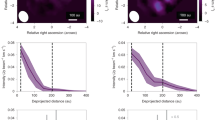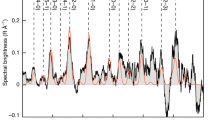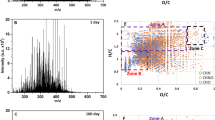Abstract
Observations of comets and asteroids show that the solar nebula that spawned our planetary system was rich in water and organic molecules. Bombardment brought these organics to the young Earth’s surface1. Unlike asteroids, comets preserve a nearly pristine record of the solar nebula composition. The presence of cyanides in comets, including 0.01 per cent of methyl cyanide (CH3CN) with respect to water, is of special interest because of the importance of C–N bonds for abiotic amino acid synthesis2. Comet-like compositions of simple and complex volatiles are found in protostars, and can readily be explained by a combination of gas-phase chemistry (to form, for example, HCN) and an active ice-phase chemistry on grain surfaces that advances complexity3. Simple volatiles, including water and HCN, have been detected previously in solar nebula analogues, indicating that they survive disk formation or are re-formed in situ4,5,6,7. It has hitherto been unclear whether the same holds for more complex organic molecules outside the solar nebula, given that recent observations show a marked change in the chemistry at the boundary between nascent envelopes and young disks due to accretion shocks8. Here we report the detection of the complex cyanides CH3CN and HC3N (and HCN) in the protoplanetary disk around the young star MWC 480. We find that the abundance ratios of these nitrogen-bearing organics in the gas phase are similar to those in comets, which suggests an even higher relative abundance of complex cyanides in the disk ice. This implies that complex organics accompany simpler volatiles in protoplanetary disks, and that the rich organic chemistry of our solar nebula was not unique.
This is a preview of subscription content, access via your institution
Access options
Subscribe to this journal
Receive 51 print issues and online access
$199.00 per year
only $3.90 per issue
Buy this article
- Purchase on SpringerLink
- Instant access to full article PDF
Prices may be subject to local taxes which are calculated during checkout



Similar content being viewed by others
References
Hartogh, P. et al. Ocean-like water in the Jupiter-family comet 103P/Hartley 2. Nature 478, 218–220 (2011)
Goldman, N., Reed, E. J., Fried, L. E., William Kuo, I.-F. & Maiti, A. Synthesis of glycine-containing complexes in impacts of comets on early Earth. Nature Chem. 2, 949–954 (2010)
Herbst, E. & van Dishoeck, E. F. Complex organic interstellar molecules. Annu. Rev. Astron. Astrophys. 47, 427–480 (2009)
Dutrey, A., Guilloteau, S. & Guelin, M. Chemistry of protosolar-like nebulae: the molecular content of the DM Tau and GG Tau disks. Astron. Astrophys. 317, L55–L58 (1997)
Carr, J. S. & Najita, J. R. Organic molecules and water in the planet formation region of young circumstellar disks. Science 319, 1504–1506 (2008)
Hogerheijde, M. R. et al. Detection of the water reservoir in a forming planetary system. Science 334, 338–340 (2011)
Cleeves, L. I. et al. The ancient heritage of water ice in the solar system. Science 345, 1590–1593 (2014)
Sakai, N. et al. Change in the chemical composition of infalling gas forming a disk around a protostar. Nature 507, 78–80 (2014)
Simon, M., Dutrey, A. & Guilloteau, S. Dynamical masses of T Tauri stars and calibration of pre-main-sequence evolution. Astrophys. J. 545, 1034–1043 (2000)
Guilloteau, S., Dutrey, A., Piétu, V. & Boehler, Y. A dual-frequency sub-arcsecond study of proto-planetary disks at mm wavelengths: first evidence for radial variations of the dust properties. Astron. Astrophys. 529, A105 (2011)
Takami, M. et al. Surface geometry of protoplanetary disks inferred from near-infrared imaging polarimetry. Astrophys. J. 795, 71 (2014)
Chiang, E. I. & Goldreich, P. Spectral energy distributions of T Tauri stars with passive circumstellar disks. Astrophys. J. 490, 368–376 (1997)
D'Alessio, P., Calvet, N., Hartmann, L., Muzerolle, J. & Sitko, M. in Star Formation at High Angular Resolution (eds Burton, M. G., Jayawardhana, R. & Bourke, T. L.) 403–410 (IAU Symp. Vol. 221, 2004)
Dutrey, A. et al. Chemistry in disks. I. Deep search for N2H+ in the protoplanetary disks around LkCa 15, MWC 480, and DM Tauri. Astron. Astrophys. 464, 615–623 (2007)
Öberg, K. I. et al. The disk imaging survey of chemistry with SMA. I. Taurus protoplanetary disk data. Astrophys. J. 720, 480–493 (2010)
Pontoppidan, K. M. et al. A Spitzer survey of mid-infrared molecular emission from protoplanetary disks. I. Detection rates. Astrophys. J. 720, 887–903 (2010)
Walsh, C., Millar, T. J. & Nomura, H. Chemical processes in protoplanetary disks. Astrophys. J. 722, 1607–1623 (2010)
Walsh, C. et al. Complex organic molecules in protoplanetary disks. Astron. Astrophys. 563, A33 (2014)
Mumma, M. J. & Charnley, S. B. The chemical composition of comets: emerging taxonomies and natal heritage. Annu. Rev. Astron. Astrophys. 49, 471–524 (2011)
Semenov, D. & Wiebe, D. Chemical evolution of turbulent protoplanetary disks and the solar nebula. Astrophys. J. Suppl. Ser. 196, 25 (2011)
van Dishoeck, E. F., Blake, G. A., Jansen, D. J. & Groesbeck, T. D. Molecular abundances and low-mass star formation. II. Organic and deuterated species toward IRAS 16293–2422. Astrophys. J. 447, 760–782 (1995)
Ciesla, F. J. & Sandford, S. A. Organic synthesis via irradiation and warming of ice grains in the solar nebula. Science 336, 452–454 (2012)
Favre, C., Cleeves, L. I., Bergin, E. A., Qi, C. & Blake, G. A. A significantly low CO abundance toward the TW Hya protoplanetary disk: a path to active carbon chemistry? Astrophys. J. 776, L38 (2013)
Tsiganis, K., Gomes, R., Morbidelli, A. & Levison, H. F. Origin of the orbital architecture of the giant planets of the Solar System. Nature 435, 459–461 (2005)
Walsh, K. J., Morbidelli, A., Raymond, S. N., O'Brien, D. P. & Mandell, A. M. A low mass for Mars from Jupiter’s early gas-driven migration. Nature 475, 206–209 (2011)
Pizzarello, S. Catalytic syntheses of amino acids and their significance for nebular and planetary chemistry. Meteorit. Planet. Sci. 47, 1291–1296 (2012)
O’Brien, D. P., Walsh, K. J., Morbidelli, A., Raymond, S. N. & Mandell, A. M. Water delivery and giant impacts in the Grand Tack scenario. Icarus 239, 74–84 (2014)
Öberg, K. I., Garrod, R. T., van Dishoeck, E. F. & Linnartz, H. Formation rates of complex organics in UV irradiated CH3OH-rich ices. I. Experiments. Astron. Astrophys. 504, 891–913 (2009)
Muñoz Caro, G. M. et al. Amino acids from ultraviolet irradiation of interstellar ice analogues. Nature 416, 403–406 (2002)
Öberg, K. I. et al. Disk imaging survey of chemistry with SMA. II. Southern sky protoplanetary disk data and full sample statistics. Astrophys. J. 734, 98 (2011)
Lynden-Bell, D. & Pringle, J. E. The evolution of viscous discs and the origin of the nebular variables. Mon. Not. R. Astron. Soc. 168, 603–637 (1974)
Hartmann, L., Calvet, N., Gullbring, E. & D’Alessio, P. Accretion and the evolution of T Tauri disks. Astrophys. J. 495, 385–400 (1998)
Piétu, V., Dutrey, A., Guilloteau, S., Chapillon, E. & Pety, J. Resolving the inner dust disks surrounding LkCa 15 and MWC 480 at mm wavelengths. Astron. Astrophys. 460, L43–L47 (2006)
Dartois, E., Dutrey, A. & Guilloteau, S. Structure of the DM Tau outer disk: probing the vertical kinetic temperature gradient. Astron. Astrophys. 399, 773–787 (2003)
Rosenfeld, K. A., Andrews, S. M., Wilner, D. J., Kastner, J. H. & McClure, M. K. The structure of the evolved circumbinary disk around V4046 Sgr. Astrophys. J. 775, 136 (2013)
Qi, C. et al. Imaging of the CO snow line in a solar nebula analog. Science 341, 630–632 (2013)
Qi, C., Wilner, D. J., Aikawa, Y., Blake, G. A. & Hogerheijde, M. R. Resolving the chemistry in the disk of TW Hydrae. I. Deuterated species. Astrophys. J. 681, 1396–1407 (2008)
Qi, C. et al. Resolving the CO snow line in the disk around HD 163296. Astrophys. J. 740, 84 (2011)
Brinch, C. & Hogerheijde, M. R. LIME — a flexible, non-LTE line excitation and radiation transfer method for millimeter and far-infrared wavelengths. Astron. Astrophys. 523, A25 (2010)
Wernli, M., Wiesenfeld, L., Faure, A. & Valiron, P. Rotational excitation of HC3N by H2 and He at low temperatures. Astron. Astrophys. 464, 1147–1154 (2007)
Dubernet, M., Nenadovic, L. & Doronin, N. in Astronomical Data Analysis Software and Systems XXI (eds Ballester, P., Egret, D. & Lorente, N. P. F.) 335–338 (Conf. Ser. Vol. 461, Astronomical Society of the Pacific, 2012)
Aikawa, Y. & Herbst, E. Molecular evolution in protoplanetary disks. Two-dimensional distributions and column densities of gaseous molecules. Astron. Astrophys. 351, 233–246 (1999)
Walsh, C., Millar, T. J. & Nomura, H. Molecular line emission from a protoplanetary disk irradiated externally by a nearby massive star. Astrophys. J. 766, L23 (2013)
Aikawa, Y., Wakelam, V., Hersant, F., Garrod, R. T. & Herbst, E. From prestellar to protostellar cores. II. Time dependence and deuterium fractionation. Astrophys. J. 760, 40 (2012)
Wakelam, V. et al. A kinetic database for astrochemistry (KIDA). Astrophys. J. Suppl. Ser. 199, 21 (2012)
Cleeves, L. I., Bergin, E. A., Qi, C., Adams, F. C. & Oberg, K. I. Constraining the X-ray and cosmic ray ionization chemistry of the TW Hya protoplanetary disk: evidence for a sub-interstellar cosmic ray rate. Astrophys. J. 799, 204 (2015)
Furuya, K. & Aikawa, Y. Reprocessing of ices in turbulent protoplanetary disks: carbon and nitrogen chemistry. Astrophys. J. 790, 97 (2014)
Yamamoto, T., Nakagawa, N. & Fukui, Y. The chemical composition and thermal history of the ice of a cometary nucleus. Astron. Astrophys. 122, 171–176 (1983)
Garrod, R. T. & Herbst, E. Formation of methyl formate and other organic species in the warm-up phase of hot molecular cores. Astron. Astrophys. 457, 927–936 (2006)
Collings, M. P. et al. A laboratory survey of the thermal desorption of astrophysically relevant molecules. Mon. Not. R. Astron. Soc. 354, 1133–1140 (2004)
van Dishoeck, E. F., Jonkheid, B. & van Hemert, M. C. Photoprocesses in protoplanetary disks. Faraday Discuss. 133, 231–243 (2006)
Walsh, C., Nomura, H., Millar, T. J. & Aikawa, Y. Chemical processes in protoplanetary disks. II. On the importance of photochemistry and X-ray ionization. Astrophys. J. 747, 114 (2012)
Nomura, H., Aikawa, Y., Tsujimoto, M., Nakagawa, Y. & Millar, T. J. Molecular hydrogen emission from protoplanetary disks. II. Effects of X-ray irradiation and dust evolution. Astrophys. J. 661, 334–353 (2007)
Fayolle, E. C., Öberg, K. I., Cuppen, H. M., Visser, R. & Linnartz, H. Laboratory H2O:CO2 ice desorption data: entrapment dependencies and its parameterization with an extended three-phase model. Astron. Astrophys. 529, A74 (2011)
Gratier, P. et al. The IRAM-30 m line survey of the Horsehead PDR. III. High abundance of complex (iso-)nitrile molecules in UV-illuminated gas. Astron. Astrophys. 557, A101 (2013)
Bergin, E., Calvet, N., D'Alessio, P. & Herczeg, G. J. The effects of UV continuum and Lyα radiation on the chemical equilibrium of T Tauri disks. Astrophys. J. 591, L159–L162 (2003)
Graninger, D. M., Herbst, E., Öberg, K. I. & Vasyunin, A. I. The HNC/HCN ratio in star-forming regions. Astrophys. J. 787, 74 (2014)
Acknowledgements
We acknowledge comments from E. van Dishoeck. This Letter makes use of ALMA data. ALMA is a partnership of ESO (representing its member states), NSF (USA) and NINS (Japan), together with NRC (Canada) and NSC and ASIAA (Taiwan), in cooperation with the Republic of Chile. The Joint ALMA Observatory is operated by ESO, AUI/NRAO and NAOJ. The National Radio Astronomy Observatory is a facility of the NSF operated under cooperative agreement by Associated Universities, Inc. K.I.Ö. acknowledges A. Leroy and the NAASC for assistance with calibration and imaging, and also acknowledges funding from the Simons Collaboration on the Origins of Life (SCOL), the Alfred P. Sloan Foundation, and the David and Lucile Packard Foundation. D.J.W. acknowledges funding from NASA Origins of Solar Systems (grant no. NNX11AK63).
Author information
Authors and Affiliations
Contributions
K.I.Ö. led the overall project, reduced the data, assisted by V.V.G. and R.L., and wrote the manuscript with revisions from S.M.A. and D.J.W. V.V.G., assisted by C.Q., performed the parametric modelling and abundance extraction. K.F. performed the astrochemical modelling, and interpreted the results with Y.A. All authors contributed to discussions of the results and commented on the manuscript.
Corresponding author
Ethics declarations
Competing interests
The authors declare no competing financial interests.
Additional information
The ALMA program number for the presented data is 2013.1.00226.
Extended data figures and tables
Extended Data Figure 1 Model of the physical structure of the MWC 480 protoplanetary disk.
a, Radial (distance R) and vertical (distance Z) disk temperature profile (colour: see colour scale on right, contours: the gas temperature Tkin = 20, 30, 50, 100 and 1,000 K). b, Radial (R) and vertical (Z) density profile (colour: see colour scale on the right, contours: hydrogen density nH 1010, 108, 106 and 104 cm−3). Z/R = 0.2 is marked with a dashed line.
Extended Data Figure 2 Synthetic observations of H13CN, HC3N and CH3CN for different density
slopes α. The models are based on best fit to data for different choices of α, with the ranges chosen based on the emission pattern for each molecule. Left column, H13CN; middle column, HC3N; right column, CH3CN. Top row, α = 0; middle row, α = 1; bottom row, α = 2. a–g, Integrated emission maps (colour: see colour scale on the right). Black contours are the observed [3, 4, 5, 7, 10]σ in Fig. 1. The synthesized beam is shown in the bottom left corner of each panel. Note the change in emission profile between α = 1 and 2 for HC3N.
Extended Data Figure 3 Models of gaseous CH3CN/HCN abundance ratios under different physical conditions.
a–l, The CH3CN/HCN abundance ratio on a logarithmic scale (colour: see colour scale on the bottom and numbers on contours). The ultraviolet radiation flux increases from left to right from G0 = 1 (a, d, g, j) to G0 = 10 (b, e, h, k) to G0 = 100 (c, f, i, l), where G0 is the scaling factor in multiples of the local interstellar radiation field. The ionization rate of H2 increases from top to bottom from 10−17 s−1 (a–c) to 10−16 s−1 (d–f) to 10−15 s−1 (g–i) to 10−14 s−1 (j–l).
Extended Data Figure 4 Models of gaseous CH3CN in disks with and without turbulent diffusion.
a, The abundance of CH3CN with respect to the hydrogen density nH (colour: see colour scale on the right) as a function of disk radius (R) and height scaled by the radius (Z/R) in a model without turbulence. The dashed lines indicate gas temperatures of [30, 50, 100] K. b, c, As a but in disk models that include turbulence parameterized by αz = 10−3 (b) and αz = 10−2 (c). d, The vertically integrated column density of CH3CN from a–c (solid line: αz = 0, dashed line: αz = 10−3, dotted line: αz = 10−2).
Extended Data Figure 5 Models of gaseous CH3CN/HCN ratios in disks with and without turbulent diffusion.
a–d, As in Extended Data Fig. 4 but for CH3CN/HCN ratio.
Extended Data Figure 6 Models of gas-to-ice ratios of HCN in disks with and without turbulent diffusion.
a–d, As in Extended Data Fig. 4 but for ice-to-gas ratios of HCN.
Extended Data Figure 7 Models of gas-to-ice ratios of CH3CN in disks with and without turbulent diffusion.
a–d, As in Extended Data Fig. 4 but for ice-to-gas ratios of CH3CN.
Rights and permissions
About this article
Cite this article
Öberg, K., Guzmán, V., Furuya, K. et al. The comet-like composition of a protoplanetary disk as revealed by complex cyanides. Nature 520, 198–201 (2015). https://doi.org/10.1038/nature14276
Received:
Accepted:
Issue Date:
DOI: https://doi.org/10.1038/nature14276



